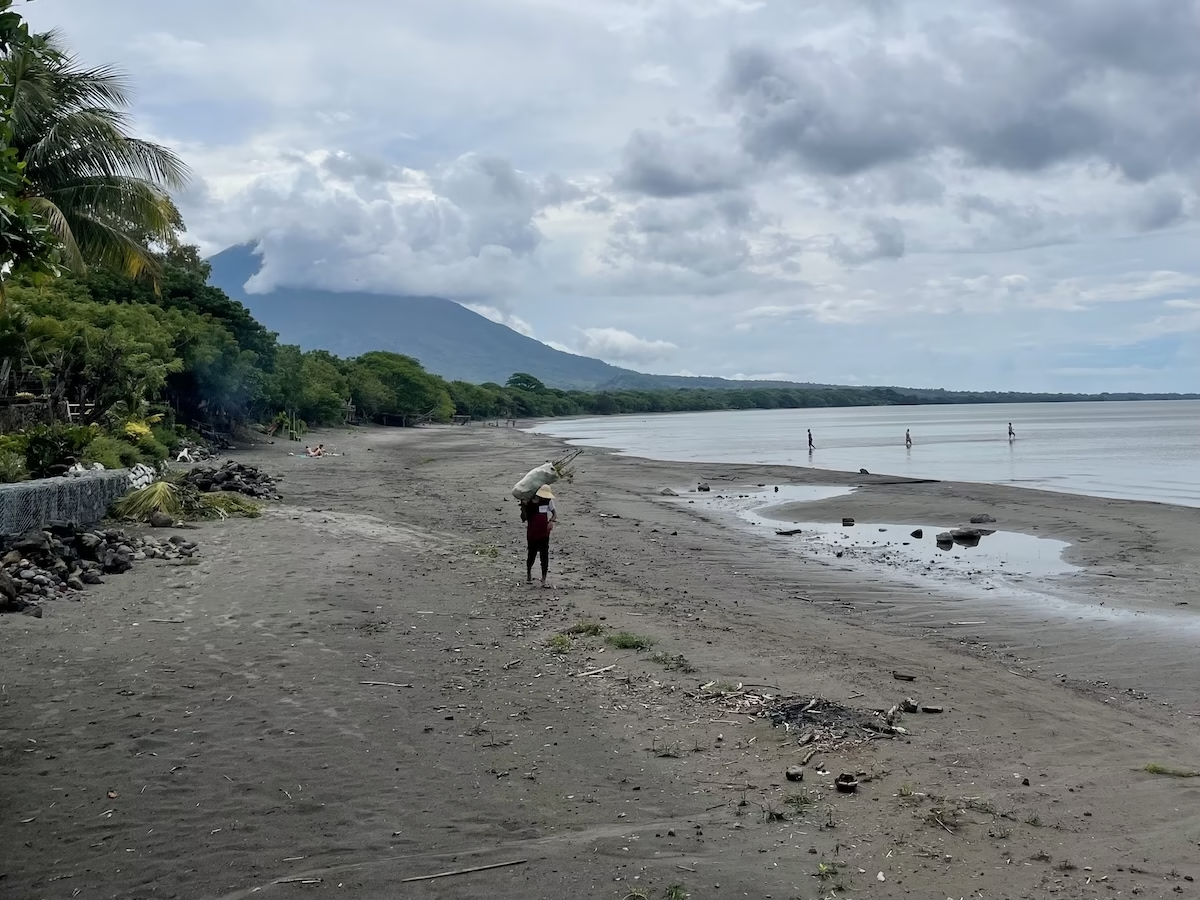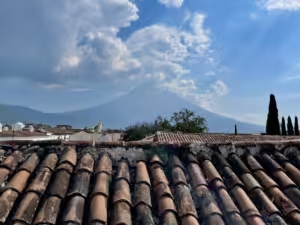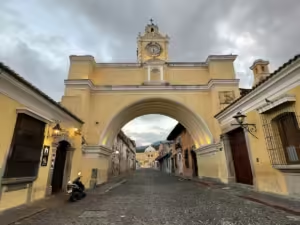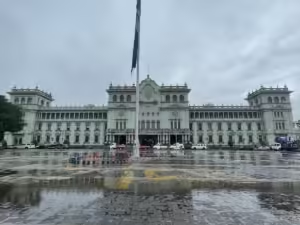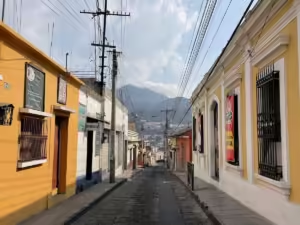The first thing you’ll see when traveling to Isla Ometepe will be two magnificent volcanoes rising up from the waters of Lake Nicaragua. One sits dormant, slopes draped in coffee farms and lush forest, its summit draped in heavy clouds. The other is barren and rocky, belching threatening smoke into the sky.
There are few other places in the world like Ometepe. The twin peaks of its volcanoes dominate the scenery, but the island is full of a thousand beautiful corners to explore. There are rural villages, beaches, hiking trails and swimming holes. Isla Ometepe is a must visit destination in Nicaragua and one of the most magnificent places in all of Central America.
What to Know Before Traveling to Isla Ometepe
As you’ve probably gathered by now, Ometepe is a volcanic island in the middle of Lake Nicaragua/Cocibolca. The two volcanoes that make up Ometepe each have their own character and personality. Volcán Concepción is active and smokes like a Chinese truck driver. For some reason, both of Ometepe’s biggest towns and most of its population resides at the foot of this active volcano. Volcán Maderas, on the other hand, is covered in tropical forest and much more sparsley populated. A narrow isthmus connects the two.
Moyogalpa is the largest town on the island, and is probably where your Ometepe adventure will start. The town’s name comes from a native word meaning “place of the mosquitos.” The ferry from the mainland drops off here, and it’s not a bad little town. The other population center is Altagracia which sits on the north side of the island. There are a number of tiny villages scattered elsewhere on both sides of the island.
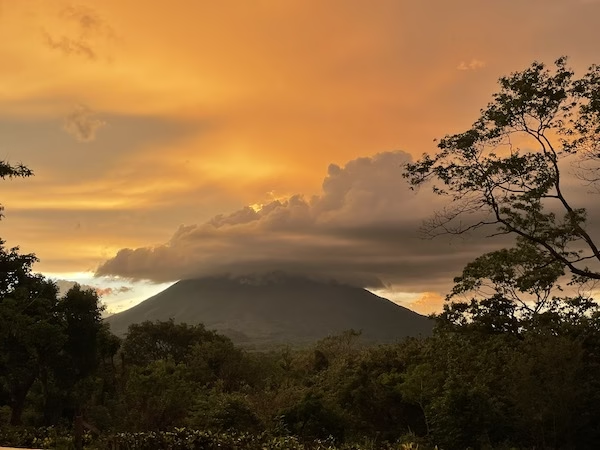
On one of the most fun, but also most stressful, aspects of travel is finding and booking places to stay. These days you have options ranging from dirt cheap hostel dorms to luxurious White Lotus style resorts. Thankfully, the internet is here to make finding accommodation easier.
Hostelworld is the go to app for finding hostels. For everything else, there’s Booking.com. If you book through either of the previous links, I’ll gain a small commission at no extra cost to you.
Both Altagracia and Moyogalpa offer a fair number of hotels and hostels. The towns are fine, but I prefer the small “village” (really just a collection of houses and a store) Santa Cruz. Santa Cruz is just on the other side of the isthmus on the Maderas side of the island near the beach and has a handful of lovely little guest houses. It’s the sort of place you feel like you’ve really gotten away from it all.
A word of warning: there’s a sort of bourgeois-hippy element that’s drawn to this part of the island. Among the pulperias and tin-roofed shacks you might stumble across dread-locked North Americans and Europeans doing yoga and drinking vegan milkshakes that cost as much as a local’s weekly salary. Thankfully, these unsavory elements can be easily avoided.
Before the hippies, native peoples such as the Chorotega and Nicarao lived on the island for thousands of years. They’ve left behind a collection of wonderful petroglyphs. During the Spanish colonial era, Ometepe was a target for pirate attacks. Thankfuly, the island has managed to avoid much of the violence that’s plagued Nicaragua in the 20th century. To this day it’s a peaceful sort of place, popular with tourists without feeling overrun.
You can learn a little more about Nicaragua’s fascinating history here: Understanding Nicaragua: A History Guide for Travelers to This Land of Resistance and Resilience
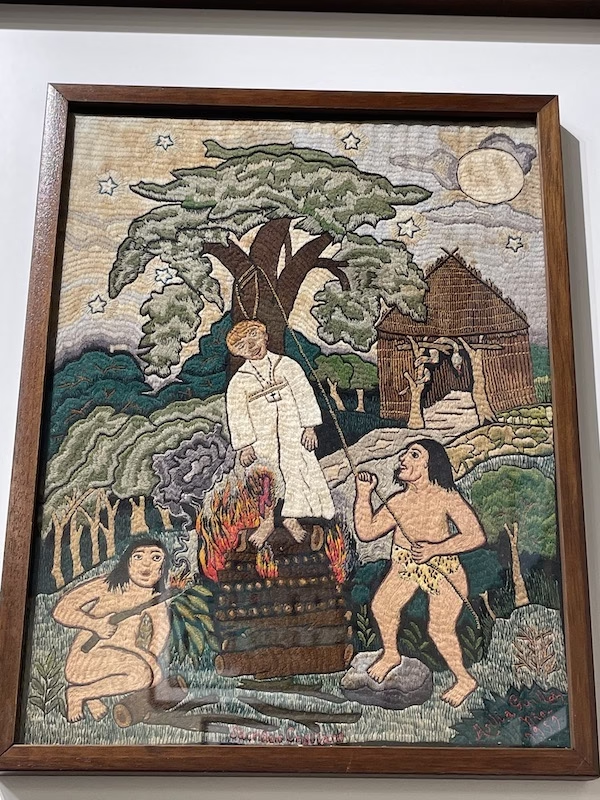
How to Get to Isla Ometepe
The best, and maybe only, way to visit Isla Ometepe is to take the ferry from Rivas. There’s an airport just south of Moyogalpa, but as far as I know flights have been suspended due to lack of demand. There used to be another ferry that ran from Granada to Altagracia and on to San Carlos, but these days it runs sporadically if at all.
You can catch a bus to the main terminal in Rivas from almost anywhere in Nicaragua. Check with your hostel or get information from Centrocoasting. Alternatively, you could just go to the bus station and listen for the guy shouting “Rivas!Rivas!Rivas!” Once you make it to Rivas, you have to head to the nearby ferry terminal at San Jorge.
Supposedly there’s a bus that goes to the terminal, but it’s easier to just catch a taxi. Ask a local how much a cab should cost. There’s an English-speaking dude that hangs out at the Rivas bus station and will try and steer you into an overpriced taxi. He’s very persistent and even followed me into the bathroom. Since we knew the price of a taxi ahead of time, we were able to talk him down to very close to the right price. Be firm but polite and remember he’s just trying to make a buck.
Once you reach the ferry terminal, head directly to the boat and pay on board. We wasted time looking for a ticket office that doesn’t exist. Another slick talking salesman steered us into his office and tried to sell us on a resort hotel and ATV rental. We left him disappointed and made the ferry just in time.
Getting to Isla Ometepe sounds complicated, but even though it’s a bit of an adventure, I promise it’s worth it.
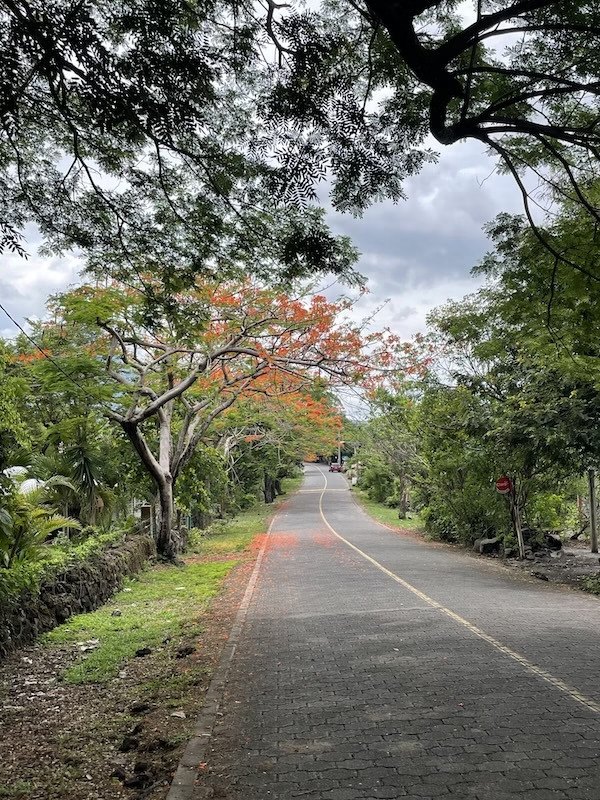
Transportation Around Isla Ometepe
Once you’re actually on Isla Ometepe, transportation becomes much easier. You can hire taxis in either of the towns, or have your accommodation arrange one for you if you’re staying far away. All the taxi we took on the island were much more upfront with their pricing and required no negotiation.
Ometepe has a bus that runs between Altagracia and Moyogalpa about once an hour. The schedule is more sporadic outside of the towns, but it’s still useable if you time it right. You’ll have to ask a local for the times, or just find a shady spot by the side of the road and wait. I wouldn’t recommend the bus if you’re in a rush. And the bus doesn’t run at all on Sunday.
A lot of travelers rent bikes or scooters to travel around Isla Ometepe. Biking is quite nice, but the island is directly under the hot, tropical sun. We biked around quite a bit and it was both lovely and sweaty.
Scooters might seem like a better idea. That is, until you run into the surprisingly large number of other tourists limping about with crutches or an arm in a sling who’ve just come from a disastrous Ometepe scooter adventure.
That is to say, transportation around Isla Ometepe is far from convenient. However, I feel that’s part of the island’s charm. Take the time to slow down and enjoy where you are instead of rushing off to wherever you’re going next.
Safety and Scams to Avoid
Isla Ometepe is very safe, at least in terms of crime. Obviously, shit happens. However, I’ve never heard of any incidents of robberies or anything else happening here. We were warned to avoid Rivas at night, and as you’ve already read above, there are a number of hustlers operating there. None of the hustlers seemed dangerous to me, though. Just annoying. And Rivas is a long boat ride away from Ometepe.
Besides crime, though, there are a few other safety issues you do actually want to be aware of on Isla Ometepe. We really did come across a lot of people who crashed their scooters on Ometepe. Outside of the main loop, the roads are pretty rough. I would also venture to guess that a number of those injured tourists were either distracted or inebriated when they had their crash.
Finally, in case I haven’t drilled it into your head enough, Isla Ometepe is very hot. Heatstroke is a real thing, and no fun. Wear plenty of sun protection and drink plenty of water. There are also a lot of biting insects lurking in the moist vegetation. Moyogalpa is the place of the mosquitos, after all. Bring repellent.
I have some more thoughts about safety and crime in Central and South America. Read them here: Rethinking Travel Safety and Crime in Latin America

Where to Stay on Isla Ometepe
Ometepe is practically bursting with hotels and hostels, ranging from scuzzy backpacker cesspools to weird pseudo hippie resorts. We didn’t stay in any of those, but did find some very lovely places, including one of my favorite hotels in Nicaragua. Maybe anywhere.
That favorite would have to be El Encanto Garden Hotel. This little property, located just over the isthmus near Volcán Maderas, offers wonderful little cabañas that are perfect for a romantic couples getaway. There’s also an onsite restaurant that serves decent meals, an incredibly friendly and helpful owner and some of the best sunset views you’re likely to find anywhere. El Encanto Garden Hotel was fantastic.
If you want to stay closer to town, Casa de Gio and Hostal Nathaly are both located a smidge closer to Moyogalpa. Neither one will win any awards, but both are very nice for reasonably priced, locally owned places to stay on Isla Ometepe. As always, if you book using one of the following links, this website will get a small commission at no cost to you.
Click here to book at El Encanto Garden Hotel
Click here to book with Casa de Gio
Click here to book with Hostal Nathaly
What to Do on Isla Ometepe
While there are plenty of things to do on Isla Ometepe, my favorite activity was doing absolutely nothing. Just kicking back with a beer and thinking about how lucky you are to be visiting this magical volcanic island in the middle of a lake. I could while away hours doing absolutely nothing but admiring Ometepe’s gorgeous scenery, and I have.
But, I suppose not every traveler is as lazy as I am. After all, you came all this way you might as well do something. Luckily, Ometepe has plenty of activities to keep even the most active traveler busy. Despite my laziness, I can recommend a number of activities.
If you absolutely must plan your activities in advance, may I suggest Get Your Guide. We’ve used them a couple of times and their tours are generally much cheaper than other sites. If you book through this link, I’ll get a small commission at no extra cost to you. Click here to see tours in Nicaragua.
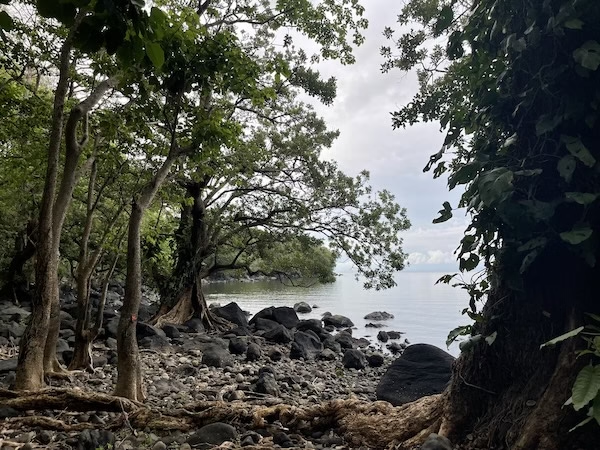
Swim in Playa Santo Domingo
The best thing to do on Isla Ometepe is also the simplest and cheapest: go for a swim. The long, narrow isthmus that connects Concepción and Maderas volcanoes has a lovely, long sandy beach. This beach, Playa Santo Domingo, is the perfect place to go jump in a lake. The water is choppy, but shallow and the waves are never too big. There’s nothing quite like bobbing up and down on a wave while you admire the volcanoes rising up on either side of you.
A small number of ramshackle beach bars and restaurants line the shore when it’s time for a snack or a drink. Some of them have some pretty delicious fish for a reasonable price. The beach is popular with locals as well as tourists, but never feels overcrowded.
Lago Cocibolca, a.k.a. Lake Nicaragua, is also home of the infamous bull shark. The only species of shark able to survive in fresh water. They’re very aggressive and dangerous, but due to overfishing you won’t come across one. Probably not.
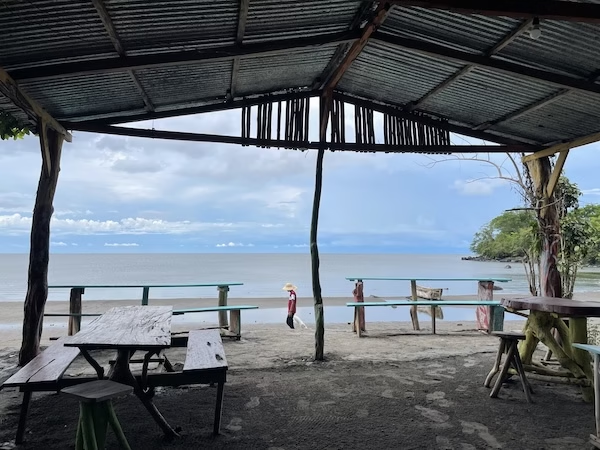
Kayak the Rio Istián
If you get tired of swimming in a shark infested lake, why not try kayaking down a caiman infested river? The Rio Istián cuts through the isthmus that connects the two halves of the island. You can see birds and occasionally monkeys here, as well as the fierce looking caimans. While they might look like ferocious crocodiles, caimans are pretty small and don’t attack people, so you won’t get bit. Probably not.
You can arrange kayak rentals and a tour through your hotel or hostel. As far as I know the tour is mandatory, but our guide was really good at pointing out wildlife we wouldn’t have seen otherwise. Besides, hiring guides is also a great way to directly funnel some money directly to the local population.
Swim in El Ojo de Agua
Unsurprisingly for an island, the top three things to do on Isla Ometepe are all water related. El Ojo de Agua is a natural swimming hole turned tourist complex. You pay to enter and you can order snacks and drinks and enjoy dips in the crystal-clear water. Local families and sometimes drunken Israeli backpackers can crowd the place.
Despite all that, El Ojo de Agua is actually a lot of fun. It’s definitely worth an afternoon. Ojo de Agua is located on the Concepción side of the island, just before the isthmus.

Hike and Hunt for Petroglyphs Near Finca El Porvenir
If you get sick of the water and want to remain relatively dry, Ometepe has a number of trails. There’s a nice, short, little nature trail on the isthmus not too far from El Ojo de Agua. The best trails, however, are on the Maderas side of the island. Here you can hunt for some of Ometepe’s famous ancient petroglyphs.
These old stone carvings are scattered throughout the island. Some of the best places to see them are on the trails near Finca el Porvenir, just south of the village of Santa Cruz. Some people say that Finca Magdelena near Balgüe is also nice. The trails eventually lead all the way up to the top of the volcano, but definitely don’t attempt this without a guide, since they aren’t very straightforward.
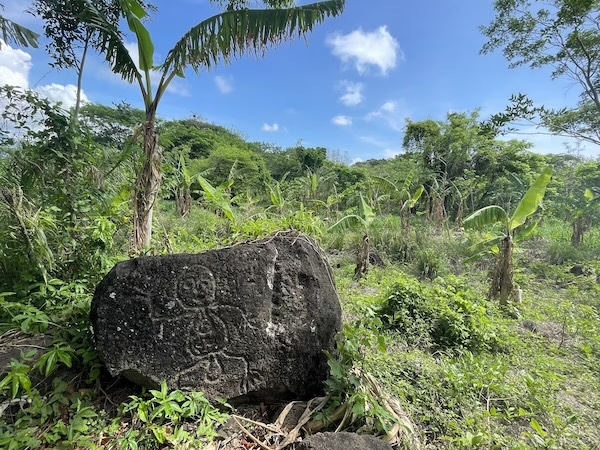
Climb One or Both of the Volcanoes
If you absolutely must climb to the top of one of Ometepe’s volcanoes, you can arrange a guide through your hostel or hotel. Both Concepción and Maderas have long, difficult trails leading up to the summit. I never went up Concepción, but a 65-year-old solo traveler (and personal hero) I met said it was nice. The climb is difficult, and there isn’t any shade but the views are supposed to be quite nice.
I did climb up Volcan Maderas. I can’t say I recommend it. We started early and spent all day trekking through thick mud up to the lagoon at the top. It was pretty, but the problem is that since the hike is so long, you’re inevitably rushed. The hike left no time to admire the gorgeous scenery or search for wildlife.
When we got to the top, our guide turned to me with a concerned look and said “You know, I really don’t understand this trekking thing. Why pay so much money just to be exhausted?” An excellent question that I still don’t have an answer to.
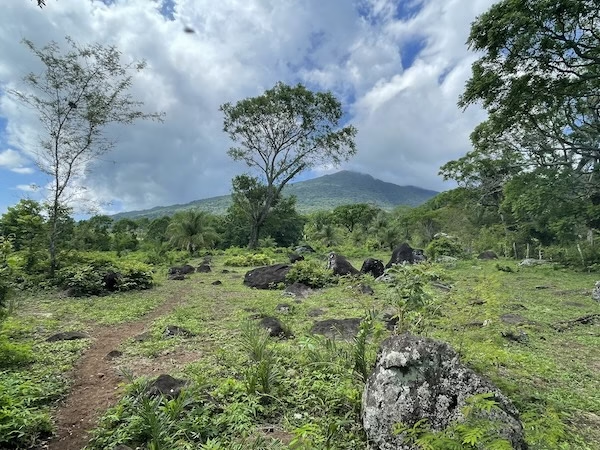
Watch the Sunset
The sunsets on Isla Ometepe are some of the best I’ve ever seen. Every evening at around six o’clock, the sun sinks below the horizon and the sky bursts with the deepest reds, oranges, pinks and purples you’ve ever seen in your life. If you’re positioned right, you’ll see the sun drop behind the silhouette of Volcán Concepción. Everyone in our hotel, including the staff, would gather together each evening to watch this astounding natural performance. The only downside is that the photos never quite capture it, do they?
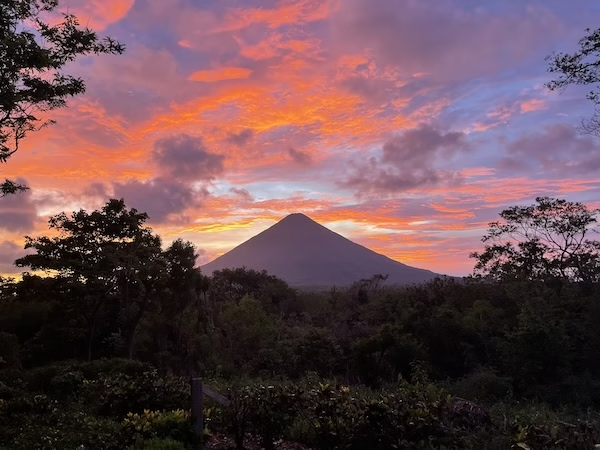
Is Isla Ometepe Worth Visiting?
Ometepe’s worth it for the sunsets alone. If you’re considering traveling to Nicaragua, then you absolutely have to make time for Isla Ometepe. The island is worth at least three full days, but you could easily stay longer. I’ve been there twice already for various amounts of time. There’s a reason it’s is a must-see travel destination.
I’m not sure what it is exactly that gives Isla Ometepe its enduring appeal. It could be the majesty of the island’s two contrasting volcanoes. Or maybe it’s the friendly locals in the villages that dot the landscape and fulfill your exact expectations of what rural Nicaraguan life should look like. It could be the beach or the monkeys, or maybe it’s just the exquisite sunsets. No matter what it is, Isla Ometepe is truly a magical place. I know I’ll be back some day.
Read more about Nicaragua’s other magical destinations here: Navigating Nicaragua: A Travel Guide to the Land of Lakes and Volcanoes and Revolution
Useful Websites for Traveling Nicaragua
As much as we might long for the days when you could show up to a town with nothing more than a beat-up guidebook and a sense of adventure, today much of traveling involves being glued to our phones making bookings. I’ve compiled some helpful apps and websites below that at least help make those bookings more convenient so you can spend less time staring at your phone and more time exploring at your surroundings. Some of these sites are affiliate links that give me a small commission at no cost to you if you chose to book through them. All of them are sites I’ve used personally and have no problem recommending.
Just be sure to do your due diligence as much as possible. Only hire local guides and try as much as possible to stay in locally owned hotels and hostels so that your hard earned travel dollars actually go to support the local economies of the places you visit.
Booking.com is basically the world’s only hotel booking website. They have hotels, guesthouses and vacation rentals all over Nicaragua.
Hostelworld is the go-to site for booking hostels. If dorm rooms and shared bathrooms are your thing, you’ll find hostels all over Nicaragua.
Get Your Guide offers tours and activities all around the world. Unlike some other sites and apps that do the same thing, you can actually find some reasonably priced deals here.
Centro Coasting is a great website to look up bus routes and times throughout Central America. Schedules change regularly, and the site is sometimes not as up to date as you’d like. However, it’s a good resource to help give you an idea when the buses leave, or at least get you to the right terminal.

